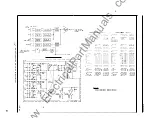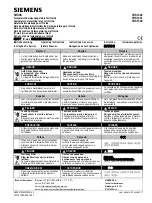
module and apply rated de voltage. Also apply
phase current to phase A input. The voltage at test
point TP3 on the overcurrent module should drop
from approximately 23.5 volts to less than 2.5 V de
when the ac current input is between .48 and .52
amperes. The AR output relay will pickup at the
same time.
Use the same test with applying current to
phase C (and also phase B if used). Pickup should
be within 5% of the phase A pickup.
Rotate Tap Multiplier Knob to the X3 setting
and repeat above. The operate current should be
between 1 .44 and 1 .56 amperes on phase A input
and within 5% of phase A pickup for phase C (and
phase B if used).
For setting Phase A current operate level, set
the tap screw in the proper range location and set
the phase tap multiplier at the point at which the
voltage at TP3 changes from high to low at the
desired input current. The phase C and Phase B (if
used) tap screws should be set for the same current
range.
The Ground overcurrent setting is checked and
set exactly like the phase overcurrent circuit.
A locking feature is provided to hold the tap
multiplier knob at the desired setting.
Control Timer
Use a low bounce initiate contact in series with
relay terminal 9 (positive). Connect an electronic
timer to the relay so that the start input is con
nected to relay terminal 9 (through a voltage
divider, if necesary). The stop input should be con
nected to the bottom test jack on the timer
module. The common should be connected to ter
minal 8. The test timer start input should be ad
justed to commence timing on a positive going
slope and to stop timing on a negative going slope.
The control timer output should go from a high
state to a low state in 1 90 to 2 1 0 milliseconds.
If some other time interval is desired, the timer
setting may be changed by means of a screw driver
adjustment through the access hole on the timer
6
module to a multiturn potentiometer. Use the elec
tronic test timer in the manner described to obtain
the desired time interval. Remember that the Con
trol Timer should always be set at least 1 6
milliseconds longer than the B F timer. The adjust
ment range is 1 50 to 250 ms.
BREAKER FAI L U R E (BF)
T I M E R
This may be checked i n the same way a s the
Control Timer.
First jumper test points TP6 and TP7 on the
timer module. Connect the test timer stop lead to
the upper test jack on the timer module. Output of
the B F timer takes place when it goes from a high
state to low state (similar to the Control Timer
output).
Set the timer knob at the desired setting and
verify setting by operating the timer several times.
The timer should operate within 5 % of the setting.
The setting may be made closer by means of the
electronic test timer.
When the desired setting has been obtained it
may be locked in place by means of the locking
tab.
Overall operation may be checked by connec
ting rated de voltage to relay terminal 1 8 (52A
breaker auxiliary contact input).
Remove jumper from test point TP6 and TP7
on the timer module.
Now when the test switch to terminal 9 is clos
ed, the AR output relay should pickup momentari
ly and reset even though the test switch is left clos
ed. Remember that the B F timer setting should be
1 6 ms or more longer than the Control Timer.
Reduce voltage to relay terminal 1 8 to 60% of
rated relay voltage. Close test switch and note that
AR relay does not pickup.
Return voltage to normal and reduce voltage to
terminal 9 to 60% of rated relay voltage. Close test
switch and note that AR relay does not pick up.
www
. ElectricalPartManuals
. com







































